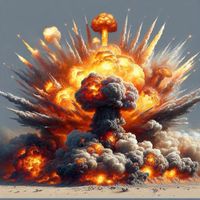On October 2, 2025, the usually lively corridors of Tehran University’s engineering and technical college were rocked by a devastating explosion that claimed one life and left four others injured. The incident, which unfolded in the Amirabad neighborhood—a bustling area of the Iranian capital—has cast a spotlight on laboratory safety, infrastructure reliability, and the growing number of similar incidents plaguing Tehran in recent months.
According to multiple local media reports, the blast occurred inside a two-story educational building on North Kargar Street, specifically within a ground-floor laboratory. Jalal Maleki, spokesperson for the Tehran Fire Department, provided crucial details, stating that the explosion was triggered when a hydrogen cylinder was being replaced in the lab. "The explosion was so powerful that windows, doors, and part of the internal wall were destroyed," Maleki told reporters, as cited by Caliber.Az and other outlets.
Eyewitnesses in the area described a scene of chaos and confusion, with a loud bang reverberating through the neighborhood, followed by the sight of smoke and debris. For many, the immediate aftermath was a blur of emergency sirens and frantic efforts to account for everyone inside the building. The force of the blast was such that not only were structural elements of the lab destroyed, but flying glass and debris caused injuries to several people nearby.
"Fortunately, the incident did not lead to fire or secondary explosions. The situation is fully under control and firefighters are conducting safety operations," Maleki emphasized, as reported by local news agencies. While the initial explosion sparked fears of a wider disaster, emergency responders acted swiftly, containing the situation and preventing further escalation. The fire that did break out was quickly brought under control, and safety checks were immediately put in place to ensure no lingering hazards remained.
Tragically, one man died instantly at the scene. A man and a woman sustained severe injuries, and several others suffered lighter wounds—mostly from flying glass and debris. The more seriously injured victims were transported to local hospitals, where they remain under medical care, while those with minor injuries received treatment on-site or at nearby medical facilities.
The precise cause of the explosion is still under investigation, but early indications point to the hydrogen cylinder as the culprit. Hydrogen, widely used in engineering and scientific research, is highly flammable and can pose significant risks if not handled with meticulous care. "The blast is believed to have been caused by a hydrogen gas capsule used in the lab," Maleki reiterated, according to reports from Mehr and Caliber.Az.
This tragic event has intensified scrutiny of laboratory safety practices—not just at Tehran University, but across the city. In recent months, Tehran has witnessed a string of fires and explosions, many of which have been attributed to gas leaks or electrical short circuits. The frequency of such incidents has raised uncomfortable questions about the adequacy of current safety protocols, the condition of aging infrastructure, and the level of oversight in facilities where hazardous materials are handled daily.
For the university community, the explosion has been a sobering reminder of the risks inherent in scientific research and experimentation. The engineering and technical college, known for its rigorous academic standards and cutting-edge work, now faces the difficult task of reviewing its safety procedures and supporting those affected by the blast. Administrators have pledged full cooperation with the ongoing investigation, and counseling services have been made available to students and staff traumatized by the event.
Beyond the university walls, the incident has prompted broader public debate about Tehran’s preparedness for emergencies involving hazardous materials. While the city’s emergency responders were widely praised for their rapid reaction, some critics argue that more proactive measures are needed to prevent such disasters from occurring in the first place. Calls for stricter inspections, better training, and updated safety equipment have grown louder in the wake of Thursday’s explosion.
There is also the question of infrastructure. Tehran, a city with a dense population and a mix of old and new buildings, faces unique challenges when it comes to maintaining safety standards. Many of the recent fires and explosions have been linked to gas leaks, outdated wiring, or faulty equipment—problems that are difficult to address without significant investment and a coordinated approach from both public authorities and private institutions.
As the investigation into the Tehran University explosion continues, authorities are under pressure to identify not only the immediate technical cause of the blast, but also any systemic issues that may have contributed to the tragedy. Was the hydrogen cylinder properly maintained? Were staff and students adequately trained in handling such materials? Did the building’s safety systems function as intended? These are just some of the questions investigators are now working to answer.
For those who witnessed the explosion or were caught in its aftermath, the emotional toll is likely to linger. The suddenness of the event, the loss of life, and the injuries sustained have left a mark on the university community and the city at large. As one local resident put it, "You never expect something like this to happen so close to home. It makes you wonder about the safety of all the places we go every day."
In the coming weeks, the findings of the official investigation are expected to shape the response—not only in terms of accountability, but also in the implementation of new safety measures. University officials have already signaled their intention to review laboratory protocols and invest in updated safety equipment. Meanwhile, city authorities are facing renewed demands to inspect other high-risk facilities and upgrade aging infrastructure wherever possible.
The tragedy at Tehran University serves as a stark reminder of the delicate balance between scientific progress and safety. As research institutions continue to push the boundaries of knowledge, the need for vigilant oversight and robust safety practices becomes ever more pressing. The hope now is that the lessons learned from this incident will lead to meaningful improvements—not just at one university, but across Tehran’s many laboratories, workshops, and classrooms.
For now, a community mourns its loss, tends to its wounded, and waits for answers—determined that such a tragedy should not be repeated.

